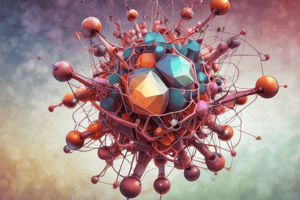Podcast
Questions and Answers
What structural change occurs when pyridine is converted to piperidine?
What structural change occurs when pyridine is converted to piperidine?
- Hydrolysis
- Reduction (correct)
- Methylation
- Oxidation
Lobeline, derived from Lobelia, is classified as a derivative of which alkaloid?
Lobeline, derived from Lobelia, is classified as a derivative of which alkaloid?
- Piperidine (correct)
- Nicotinic acid
- Pyrolidine
- Pyridine
Which of the following alkaloids is a derivative of nicotinic acid?
Which of the following alkaloids is a derivative of nicotinic acid?
- Coniine
- Nicotine
- Lobeline
- Arecoline (correct)
Which biosynthetic precursor is incorporated into nicotine, resulting in a symmetric labeling pattern?
Which biosynthetic precursor is incorporated into nicotine, resulting in a symmetric labeling pattern?
The N-methylpyrrolinium ion is a key intermediate in the biosynthesis of nicotine. What type of reaction does it undergo with nicotinic acid?
The N-methylpyrrolinium ion is a key intermediate in the biosynthesis of nicotine. What type of reaction does it undergo with nicotinic acid?
Nicotine primarily acts as a(n) ________ at cholinergic receptors.
Nicotine primarily acts as a(n) ________ at cholinergic receptors.
Which of the following is considered the more potent carcinogen found in tobacco products, rather than nicotine itself?
Which of the following is considered the more potent carcinogen found in tobacco products, rather than nicotine itself?
Lobeline sulfate is incorporated into tablets to aid in breaking tobacco habits due to its similarity in effects to which substance?
Lobeline sulfate is incorporated into tablets to aid in breaking tobacco habits due to its similarity in effects to which substance?
Which receptor type is primarily affected by arecoline at low doses?
Which receptor type is primarily affected by arecoline at low doses?
What pharmacological effect is associated with arecoline's action on muscarinic receptors?
What pharmacological effect is associated with arecoline's action on muscarinic receptors?
Pelletierine tannate, derived from pomegranate, was historically used for what purpose?
Pelletierine tannate, derived from pomegranate, was historically used for what purpose?
Coniine and conhydrine from Conium maculatum primarily affect which system, leading to potentially fatal outcomes?
Coniine and conhydrine from Conium maculatum primarily affect which system, leading to potentially fatal outcomes?
The alkaloids present in poison hemlock act as non-depolarizing blockers at the neuromuscular junction, similar to which other substance?
The alkaloids present in poison hemlock act as non-depolarizing blockers at the neuromuscular junction, similar to which other substance?
Piperine, found in black pepper, consists of a piperidine moiety combined with what?
Piperine, found in black pepper, consists of a piperidine moiety combined with what?
Which of the following properties is associated with Piper?
Which of the following properties is associated with Piper?
What products are formed during the hydrolysis of atropine?
What products are formed during the hydrolysis of atropine?
Which two ring systems are found tropane?
Which two ring systems are found tropane?
What is the direct precursor to tropic acid in the biosynthesis of tropane alkaloids?
What is the direct precursor to tropic acid in the biosynthesis of tropane alkaloids?
Which of the following statements accurately compares hyoscyamine and atropine?
Which of the following statements accurately compares hyoscyamine and atropine?
Which process leads to the formation of atropine from hyoscyamine during the extraction of alkaloids from Atropa belladonna?
Which process leads to the formation of atropine from hyoscyamine during the extraction of alkaloids from Atropa belladonna?
What effect does belladonna have on secretions in the body?
What effect does belladonna have on secretions in the body?
Identify the use of belladonna that relates to its parasympathetic depressant action.
Identify the use of belladonna that relates to its parasympathetic depressant action.
Which of the following correctly characterizes the alkaloid content of Hyoscyamus muticus (Egyptian henbane) compared to Hyoscyamus niger?
Which of the following correctly characterizes the alkaloid content of Hyoscyamus muticus (Egyptian henbane) compared to Hyoscyamus niger?
For what purpose is powdered stramonium primarily used?
For what purpose is powdered stramonium primarily used?
Which therapeutic effect is common among belladonna, hyoscyamus, and stramonium?
Which therapeutic effect is common among belladonna, hyoscyamus, and stramonium?
In the treatment of peptic ulcers, what role do drugs like stramonium play?
In the treatment of peptic ulcers, what role do drugs like stramonium play?
Which amino acid serves as the precursor to the benzoyl group in cocaine biosynthesis?
Which amino acid serves as the precursor to the benzoyl group in cocaine biosynthesis?
What are the three basic types of alkaloids found in coca leaves?
What are the three basic types of alkaloids found in coca leaves?
Which of the following describes the primary route of administration for cocaine as a recreational drug?
Which of the following describes the primary route of administration for cocaine as a recreational drug?
What concentration range is cocaine hydrochloride typically used in when applied topically as a local anesthetic?
What concentration range is cocaine hydrochloride typically used in when applied topically as a local anesthetic?
During tropane alkaloid biosynthesis, from which molecule are the three carbon atoms derived and incorporated to complete the piperidine moiety?
During tropane alkaloid biosynthesis, from which molecule are the three carbon atoms derived and incorporated to complete the piperidine moiety?
Identify the semi-synthetic derivative of scopolamine.
Identify the semi-synthetic derivative of scopolamine.
Which specific enzyme catalyzes the epoxidation of atropine to form hyoscine (scopolamine)?
Which specific enzyme catalyzes the epoxidation of atropine to form hyoscine (scopolamine)?
Flashcards
Piperidine
Piperidine
Upon reduction, pyridine is converted to this secondary base.
Nicotine
Nicotine
A ganglionic (nicotinic) cholinergic receptor agonist found in tobacco with complex pharmacologic actions.
Lobelia (Indian Tobacco)
Lobelia (Indian Tobacco)
Dried leaves & tops of Lobelia inflata F: Lobeliaceae containing piperidine and N-methyl derivatives.
Lobeline
Lobeline
Signup and view all the flashcards
Areca
Areca
Signup and view all the flashcards
Arecoline Hydrobromide
Arecoline Hydrobromide
Signup and view all the flashcards
Pomegranate Root and Stem Bark (Granatum)
Pomegranate Root and Stem Bark (Granatum)
Signup and view all the flashcards
Conium (Poison Hemlock)
Conium (Poison Hemlock)
Signup and view all the flashcards
Piper (Black Pepper)
Piper (Black Pepper)
Signup and view all the flashcards
Piperine
Piperine
Signup and view all the flashcards
Tropane
Tropane
Signup and view all the flashcards
Tropine
Tropine
Signup and view all the flashcards
Hyoscyamine Formation
Hyoscyamine Formation
Signup and view all the flashcards
Atropine
Atropine
Signup and view all the flashcards
Hyoscine (Scopolamine)
Hyoscine (Scopolamine)
Signup and view all the flashcards
Belladonna (Deadly Night Shade)
Belladonna (Deadly Night Shade)
Signup and view all the flashcards
Belladonna Uses
Belladonna Uses
Signup and view all the flashcards
Hyoscyamus (Henbane)
Hyoscyamus (Henbane)
Signup and view all the flashcards
Stramonium (Datura stramonium)
Stramonium (Datura stramonium)
Signup and view all the flashcards
Anticholinergic Effect
Anticholinergic Effect
Signup and view all the flashcards
Cocaine
Cocaine
Signup and view all the flashcards
Cocaine (Chemical)
Cocaine (Chemical)
Signup and view all the flashcards
Study Notes
Pyridine-Piperidine-Pyrolidine Alkaloids
- Reduction converts the tertiary base pyridine into the secondary base piperidine.
- These two nuclei form the basis for this group of alkaloids.
- This group is sometimes divided into three subgroups: derivatives of piperidine, derivatives of nicotinic acid, and derivatives of both pyridine and pyrolidine.
- Example of piperidine derivative: lobeline from lobelia.
- Example of nicotinic acid derivative: arecoline from areca.
- Example of pyridine-pyrolidine derivative: nicotine from tobacco.
Biosynthesis of Pyridine-Piperidine Alkaloids
- Nicotine biosynthesis:
- Tobacco plants incorporate ornithine into nicotine.
- This incorporation leads to a symmetric labeling pattern in the nicotine molecule.
- The N-methylpyrrolinium ion serves as a key intermediate that attaches to C-3 of the pyridine ring of nicotinic acid via electrophilic aromatic substitution.
Drugs Containing Pyridine-Piperidine Alkaloids
Tobacco
- Dried leaves of Nicotiana tabacum (Solanaceae).
- Cultivated for smoking.
- Contains 0.6-0.9% alkaloids.
- Nicotine:
- An oily liquid alkaloid that turns yellow upon oxidation.
- Acts as a ganglionic (nicotinic) cholinergic receptor agonist with complex pharmacological actions.
- Chronic use may lead to psychological and physical dependence.
- Causes peripheral vasoconstriction, atrial tachycardia, and increased blood pressure.
- Is linked to heart disease and lung cancer in smokers where 50% of smokers die of heart disease and 20% die of lung cancer.
- Carcinogenicity is likely due to N-nitroso nor nicotine rather than nicotine itself.
- N-nitroso nor nicotine found in cigarettes, cigars, and chewing tobacco; even parts per billion concentrations pose health hazards.
Lobelia (Indian Tobacco)
- Dried leaves and tops of Lobelia inflata (Lobeliaceae/Campanulaceae).
- Contains 14 alkaloids, including piperidine and N-methylpiperidine derivatives, with lobeline as the major component.
- Lobeline:
- Exists as colorless crystals, slightly soluble in water but soluble in hot alcohol.
- Used for expectorant purposes.
- Acts as a respiratory stimulant, but its effects are unreliable and brief.
- Has effects similar to nicotine.
- Used (0.5 to 1.5 mg doses of lobeline sulfate) in tablets or lozenges to aid in breaking tobacco habits and other drug addictions like amphetamines, cocaine, or alcohol.
Areca
- Dried, ripe seed of Areca catechu (Palmae).
- Contains reduced pyridine derivative alkaloids.
- Includes arecoline (arecaidine methyl ester), arecaidine (N-methyl guvacine), guvacine (tetrahydronicotinic acid), and guvacoline (guvacine methyl ester).
- Total alkaloid content is up to 0.45%.
- Uses:
- Arecoline hydrobromide is used in veterinary medicine as an anthelmintic drug.
- Arecoline:
- Parasympathomimetic (agonist) that acts on muscarinic receptors and, at high doses, on nicotinic receptors.
- Causes vasodilation, hypotension, reflex tachycardia (low doses), stimulation of intestinal tone and peristalsis, increased secretions, miosis, and bladder contraction.
Pomegranate
- Pomegranate Root and Stem Bark or Granatum derived from Punica granatum (Punicaceae).
- Contains 0.5–0.9% volatile liquid alkaloids.
- Includes pelletierine and pseudopelletierine, along with approximately 22% tannin.
- Pelletierine tannate was used as an anthelmintic, specifically against tapeworms.
Conium (Poison Hemlock)
- Full-grown, unripe fruit of Conium maculatum (Umbellifereae).
- Contains alkaloids, including coniine and conhydrine.
- Used as an antispasmodic.
- Poisonous to humans and animals, potentially causing central nervous system depression, respiratory failure, acute rhabdomyolysis, acute renal failure, and death.
- Acts as a non-depolarizing blocker at the neuromuscular junction, similar to curare.
Piper
- Dried, full-grown, unripe fruit of Piper nigrum (Piperaceae).
- Contains 4.5-8% piperine.
- Primarily used as a condiment.
- Black pepper comes from unripe fruits, while white pepper comes from ripe fruits.
- Possesses irritant, stimulant, and febrifuge properties.
- Piperine structure: a piperidine moiety combined with piperic acid through an amide function.
- Hydrolysis of piperine yields piperidine, a liquid alkaloid.
Tropane Alkaloids
- Key alkaloids: (-)-hyoscyamine, atropine (racemate of hyoscyamine), and hyoscine (scopolamine).
- These compounds are esters, hydrolyzed by heating at 60°C with baryta water.
- Atropine yields tropic acid and tropine upon hydrolysis.
- Hyoscine yields tropic acid and oscine (formed via enzymatic hydrolysis, converted to oscine via chemical treatment).
- Extremely poisonous.
- Tropane:
- A bicyclic amine with a pyrrolidine and a piperidine ring sharing a common nitrogen atom and two carbon atoms.
- A dicyclic compound formed by condensation of a pyrrolidine precursor (ornithine) with three carbon atoms derived from acetate.
- The 3-hydroxy derivative is known as tropine.
- Esterification of tropine with (-)-tropic acid yields hyoscyamine, which can be racemized to form atropine.
Biosynthesis of Tropane Alkaloids
- Hyoscyamine and Scopolamine:
- Ornithine is stereospecifically incorporated to form the pyrrolidine ring of tropine.
- The remaining three carbon atoms come from acetate, completing the piperidine moiety.
- Methylation via transmethylation from a donor like methionine completes the tropine nucleus.
- Esterification of tropic acid with tropine produces hyoscyamine.
- Tropic acid is formed by intramolecular rearrangement of phenyllactate.
- Tropane Alkaloids Classification:
- Solanaceous
- Erythroxylon (Coca)
Solanaceous Tropane Alkaloids
- (-)-isomer is hyoscyamine, (+)-isomer not typically found in the plant.
- Atropine is the racemic form of hyoscyamine.
- Hyoscyamine is more active than atropine.
- Hyoscine (scopolamine) is an epoxide of atropine and exists as the (-)-isomer.
- Atrosine is the (±)-isomer of scopolamine.
- Over 200 tropane alkaloids have been recorded.
Drugs Containing Tropane Alkaloids
Belladonna (Deadly Nightshade Leaf)
- Dried leaf or root of Atropa belladonna (Solanaceae).
- Root has a higher alkaloid concentration (0.6%) than the leaves (0.4%).
- Alkaloids in the leaf: (-) hyoscyamine and traces of atropine (formed during extraction).
- Root contains apoatropine, belladonnine, and scopolamine.
- Uses:
- Parasympathetic depressant and spasmolytic agent.
- Anticholinergic properties used to control gastrointestinal tract motor activity and urinary tract spasms.
- Decreases intestinal tone and paralyzes the ureters.
- Reduces secretion flow (saliva, milk, sweat).
- Induces passive mydriasis (pupil dilation).
- Increases heart rate by suppressing vagal inhibition after a temporary bradycardia.
- Causes vasodilation of cutaneous capillaries at toxic doses, especially on the face.
Hyoscyamus (Henbane)
- Dried leaves and flowering tops of Hyoscyamus niger (Solanaceae).
- Contains 0.04% total alkaloids (calculated as hyoscyamine), hyoscine, and traces of atropine.
- Used as a parasympatholytic agent, but the crude drug use in medicine is rare today.
- Egyptian Henbane (Hyoscyamus muticus):
- Has a much higher alkaloid content (around 1.5%)
- Consisting largely of hyoscyamine.
- Cultivated in Egypt primarily for alkaloid extraction.
Stramonium (Datura stramonium)
- Dried leaves and flowering tops of Datura stramonium (Solanaceae).
- Contains up to 0.4% total alkaloids (calculated as hyoscyamine).
- Acts as an anticholinergic agent, similar to belladonna.
- Powdered Stramonium is used in preparations to be burned and inhaled for asthma relief.
- All of the above drugs are used as mydriatics, antispasmodics, parasympatholytics, and to decrease secretions (sweat, saliva, milk, etc.).
- Used as adjunctive therapy for peptic ulcers, functional digestive disorders, and diarrhea.
Cocaine Biosynthesis
- Feeding experiments with Erythroxylon coca have shown phenylalanine is incorporated into cocaine with radioactivity in the benzoyl group.
- The ecgonine moiety likely derives from ornithine and acetate.
Cocaine
- Habit-forming drug from the leaves of Erythroxylum coca (Erythroxylaceae).
- Coca leaves contain three types of alkaloids:
- Ecgonine derivatives (cocaine, cinnamyl cocaine, α & β truxilline).
- Tropine derivatives (tropacocaine, valerine).
- Hygrine derivatives (hygroline, cuscohygrine).
- Ecgonine derivatives are the most commercially important, especially cocaine.
- Cocaine:
- Methyl ester of benzoyl ecgonine.
- Abused substance, inhaled or snorted, absorbed rapidly across pharyngeal mucosa.
- Results in cerebral stimulation and euphoria.
- Cocaine hydrochloride acts as a local anesthetic.
- Applied topically to mucous membranes as a 2-5% solution.
Studying That Suits You
Use AI to generate personalized quizzes and flashcards to suit your learning preferences.




